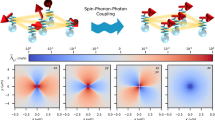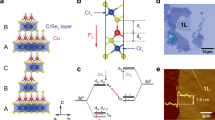Abstract
Multiferroics are compounds in which at least two ferroic orders coexist, typically ferroelectricity and some form of magnetism. While magnetic order can arise in both insulating and metallic compounds, ferroelectricity is in principle only allowed in insulators, although ferroelectric metals have been proposed and several two-dimensional systems have been reported to behave in this way. However, their combination with and coupling to magnetic order have not been realized thus far. Here we show the coexistence of ferroelectricity and magnetism in an oxide-based two-dimensional electron gas. We report a modulation of the Ti–O polar displacements depending on the ferroelectric polarization direction, and a voltage-induced hysteresis of the sheet resistance that is reminiscent of the ferroelectric polarization loop. The transport properties of the electron gas display an anomalous Hall effect and magnetoresistance that can both be modulated and cycled by switching the remanent polarization, demonstrating a magnetoelectric coupling. Our findings provide new opportunities in quantum matter that stem from the interplay between ferroelectricity, ferromagnetism, metallicity and Rashba spin–orbit coupling.
This is a preview of subscription content, access via your institution
Access options
Access Nature and 54 other Nature Portfolio journals
Get Nature+, our best-value online-access subscription
$29.99 / 30 days
cancel any time
Subscribe to this journal
Receive 12 print issues and online access
$209.00 per year
only $17.42 per issue
Buy this article
- Purchase on Springer Link
- Instant access to full article PDF
Prices may be subject to local taxes which are calculated during checkout





Similar content being viewed by others
Data availability
The data that support the findings of this study are available at https://doi.org/10.5281/zenodo.7551336.
References
Anderson, P. W. & Blount, E. I. Symmetry considerations on martensitic transformations: ferroelectric metals? Phys. Rev. Lett. 14, 217–219 (1965).
Shi, Y. et al. A ferroelectric-like structural transition in a metal. Nat. Mater. 12, 1024–1027 (2013).
Fei, Z. et al. Ferroelectric switching of a two-dimensional metal. Nature 560, 336–339 (2018).
Sharma, P. et al. A room-temperature ferroelectric semimetal. Sci. Adv. 5, eaax5080 (2019).
Kolodiazhnyi, T. et al. Thermoelectric power, Hall effect, and mobility of n-type BaTiO3. Phys. Rev. B 68, 085205 (2003).
Rischau, C. W. et al. A ferroelectric quantum phase transition inside the superconducting dome of Sr1−xCaxTiO3−δ. Nat. Phys. 13, 643–649 (2017).
Bréhin, J. et al. Switchable two-dimensional electron gas based on ferroelectric Ca:SrTiO3. Phys. Rev. Mater. 4, 041002 (2020).
Noël, P. et al. Non-volatile electric control of spin–charge conversion in a SrTiO3 Rashba system. Nature 580, 483–486 (2020).
Tokura, Y. & Nagaosa, N. Nonreciprocal responses from non-centrosymmetric quantum materials. Nat. Commun. 9, 3740 (2018).
Trier, F. et al. Oxide spin-orbitronics: spin–charge interconversion and topological spin textures. Nat. Rev. Mater. 7, 258–274 (2022).
Fiebig, M., Lottermoser, T., Meier, D. & Trassin, M. The evolution of multiferroics. Nat. Rev. Mater. 1, 16046 (2016).
Hwang, H. Y. et al. Emergent phenomena at oxide interfaces. Nat. Mater. 11, 103–113 (2012).
Vizner Stern, M. et al. Interfacial ferroelectricity by van der Waals sliding. Science 372, 1462–1466 (2021).
Yasuda, K., Wang, X., Watanabe, K., Taniguchi, T. & Jarillo-Herrero, P. Stacking-engineered ferroelectricity in bilayer boron nitride. Science 372, 1458–1462 (2021).
Gong, C. et al. Discovery of intrinsic ferromagnetism in two-dimensional van der Waals crystals. Nature 546, 265–269 (2017).
Huang, B. et al. Layer-dependent ferromagnetism in a van der Waals crystal down to the monolayer limit. Nature 546, 270–273 (2017).
Song, Q. et al. Evidence for a single-layer van der Waals multiferroic. Nature 602, 601–605 (2022).
Gui, Z. & Janotti, A. Carrier-density-induced ferromagnetism in EuTiO3 bulk and heterostructures. Phys. Rev. Lett. 123, 127201 (2019).
Stornaiuolo, D. et al. Tunable spin polarization and superconductivity in engineered oxide interfaces. Nat. Mater. 15, 278–284 (2016).
Di Capua, R. et al. Orbital selective switching of ferromagnetism in an oxide quasi two-dimensional electron gas. npj Quantum Mater. 7, 41 (2022).
Nakagawa, N., Hwang, H. Y. & Muller, D. A. Why some interfaces cannot be sharp. Nat. Mater. 5, 204–209 (2006).
Yu, L. & Zunger, A. A polarity-induced defect mechanism for conductivity and magnetism at polar–nonpolar oxide interfaces. Nat. Commun. 5, 5118 (2014).
Salluzzo, M. et al. Structural and electronic reconstructions at the LaAlO3/SrTiO3 interface. Adv. Mater. 25, 2333–2338 (2013).
Lee, P. W. et al. Hidden lattice instabilities as origin of the conductive interface between insulating LaAlO3 and SrTiO3. Nat. Commun. 7, 12773 (2016).
Katsufuji, T. & Tokura, Y. Transport and magnetic properties of a ferromagnetic metal: Eu1−xRxTiO3. Phys. Rev. B 60, R15021–R15023 (1999).
Chien, C.-L., DeBenedetti, S. & Barros, F. D. S. Magnetic properties of EuTiO3, Eu2TiO4, and Eu3Ti2O7. Phys. Rev. B 10, 3913–3922 (1974).
Bednorz, J. G. & Müller, K. A. Sr1−xCaxTiO3: an XY quantum ferroelectric with transition to randomness. Phys. Rev. Lett. 52, 2289–2292 (1984).
Tuvia, G. et al. Ferroelectric exchange bias affects interfacial electronic states. Adv. Mater. 32, 2000216 (2020).
Biscaras, J. et al. Limit of the electrostatic doping in two-dimensional electron gases of LaXO3 (X = Al, Ti)/SrTiO3. Sci. Rep. 4, 6788 (2015).
Tokura, Y. & Tomioka, Y. Colossal magnetoresistive manganites. J. Magn. Magn. Mater. 200, 1–23 (1999).
Gajek, M. et al. Tunnel junctions with multiferroic barriers. Nat. Mater. 6, 296–302 (2007).
Garcia, V. et al. Ferroelectric control of spin polarization. Science 327, 1106–1110 (2010).
Takahashi, K. S. et al. Anomalous Hall effect derived from multiple Weyl nodes in high-mobility EuTiO3 films. Sci. Adv. 4, eaar7880 (2018).
Imamura, H., Bruno, P. & Utsumi, Y. Twisted exchange interaction between localized spins embedded in a one- or two-dimensional electron gas with Rashba spin–orbit coupling. Phys. Rev. B 69, 121303 (2004).
Fert, A., Reyren, N. & Cros, V. Magnetic skyrmions: advances in physics and potential applications. Nat. Rev. Mater. 2, 17031 (2017).
Piamonteze, C. et al. X-Treme beamline at SLS: X-ray magnetic circular and linear dichroism at high field and low temperature. J. Synchrotron Rad. 19, 661–674 (2012).
Stavitski, E. The CTM4XAS program for EELS and XAS spectral shape analysis of transition metal L edges. Micron 41, 687–694 (2010).
Kresse, G. & Hafner, J. Ab initio molecular dynamics for liquid metals. Phys. Rev. B 47, 558–561 (1993).
Kresse, G. & Furthmüller, J. Efficiency of ab-initio total energy calculations for metals and semiconductors using a plane-wave basis set. Comput. Mater. Sci. 6, 15–50 (1996).
Sun, J., Ruzsinszky, A. & Perdew, J. P. Strongly constrained and appropriately normed semilocal density functional. Phys. Rev. Lett. 115, 036402 (2015).
Varignon, J., Bibes, M. & Zunger, A. Mott gapping in 3d ABO3 perovskites without Mott–Hubbard interelectronic repulsion energy U. Phys. Rev. B 100, 035119 (2019).
Paul, A., Sun, J., Perdew, J. P. & Waghmare, U. V. Accuracy of first-principles interatomic interactions and predictions of ferroelectric phase transitions in perovskite oxides: energy functional and effective Hamiltonian. Phys. Rev. B 95, 054111 (2017).
Blöchl, P. E. Projector augmented-wave method. Phys. Rev. B 50, 17953–17979 (1994).
Monkhorst, H. J. & Pack, J. D. Special points for Brillouin-zone integrations. Phys. Rev. B 13, 5188–5192 (1976).
Acknowledgements
We thank A. Barthélémy, N. Bergeal, V. Garcia, Y. Dagan, G. Tuvia and B. Kalisky for useful discussions and L.M. Vicente-Arche for the data in Extended Data Fig. 6c,d. This project received funding from the ERC advanced grant ‘FRESCO’ no. 833973, the French ANR through project ‘CONTRABASS’, the ERA-NET QUANTERA European Union’s Horizon H2020 project ‘QUANTOX’ under grant agreement no. 731473 and the Ministero dell’Istruzione, dell’Università e della Ricerca for the PRIN project ‘TOP-SPIN’ (grant no. PRIN 20177SL7HC). M. S. and Y. C. acknowledge financial support from PNRR MUR project PE0000023-NQSTI. DFT calculations took advantage of HPC resources of CRIANN through projects 2020005 and 2007013 and of CINES through DARI project A0080911453.
Author information
Authors and Affiliations
Contributions
M.B. conceived the study and supervised it with MS. Y.C. and M.S. prepared the samples, collected the reflection high-energy electron diffraction data and imaged the samples by atomic force microscopy. Preliminary transport measurements were carried out by D.S. and M.D.A. J.B. performed the complete set of polarization and magnetotransport measurements with help from S.V. The analysis was carried out by J.B. with the help of M.B., S.V., D.S. and M.S. C.P., M.S. and J.B. performed the XAS and XMCD experiment and analysed the data. M.S. performed the atomic multiplet calculations. J.V. carried out DFT calculations. M.B., M.S. and J.B. wrote the paper with input from all authors.
Corresponding authors
Ethics declarations
Competing interests
The authors declare no competing interests.
Peer review
Peer review information
Nature Physics thanks Xiaoshan Xu, Zhicheng Zhong and the other, anonymous, reviewer(s) for their contribution to the peer review of this work.
Additional information
Publisher’s note Springer Nature remains neutral with regard to jurisdictional claims in published maps and institutional affiliations.
Extended data
Extended Data Fig. 1
(a) RHEED intensity as function of time during the preparation of a LAO/ETO//Ca-STO heterostructure. (b) AFM image of the sample after growth. Each terrace is separated from its neighbours by a 4 Å high step.
Extended Data Fig. 2
Current vs voltage loop at 2 K.
Extended Data Fig. 3
Remanent polarization loop at 2 K.
Extended Data Fig. 4
a,b, Two R vs VG cycles as in Fig. 3b measured consecutively. They are virtually identical, evidencing that the resistance is modulated by ferroelectricity rather than by irreversible effects occurring on the first cycle in standard STO 2DEGs.
Extended Data Fig. 5
(a) Raw transverse resistance measured at 6 K in the Pup state. (b) Same data after antisymmetrization. (c) AHE after the subtraction of a linear slope. (d) Same as in (c) after smoothing.
Extended Data Fig. 6
Hall effect (a) and field derivative of the Hall effect (b) for a LAO/ETO//Ca-STO sample. Hall effect (c) and field derivative of the Hall effect (d) for a AlOx//STO sample. The inverted-V shape and V shape of the data in (b) and (d), respectively, indicate a non-linear component in the Hall signal, but with a sign opposite in LAO/ETO//Ca-STO compared to AlOx//STO. While in AlOx//STO (and in standard LAO/STO 2DEGs) this non-linearity is well explained by standard two-electronic bands contributions, the non-linear component in LAO/ETO//Ca-STO has a different origin, only visible when a magnetic layer is present19, and thus ascribed to anomalous Hall effect.
Extended Data Fig. 7
Comparison of the field dependence of the AHE (left axis) and the XMCD at the Eu M5 edge (right axis), both measured at 2 K and with the magnetic field perpendicular to the plane.
Extended Data Fig. 8
Low magnetic field comparison of the AHE signal at 2 K for both remanent polarization state, after rescaling the Pup signal to match the amplitude of the Pdn signal at high magnetic field.
Rights and permissions
Springer Nature or its licensor (e.g. a society or other partner) holds exclusive rights to this article under a publishing agreement with the author(s) or other rightsholder(s); author self-archiving of the accepted manuscript version of this article is solely governed by the terms of such publishing agreement and applicable law.
About this article
Cite this article
Bréhin, J., Chen, Y., D’Antuono, M. et al. Coexistence and coupling of ferroelectricity and magnetism in an oxide two-dimensional electron gas. Nat. Phys. 19, 823–829 (2023). https://doi.org/10.1038/s41567-023-01983-y
Received:
Accepted:
Published:
Issue Date:
DOI: https://doi.org/10.1038/s41567-023-01983-y



